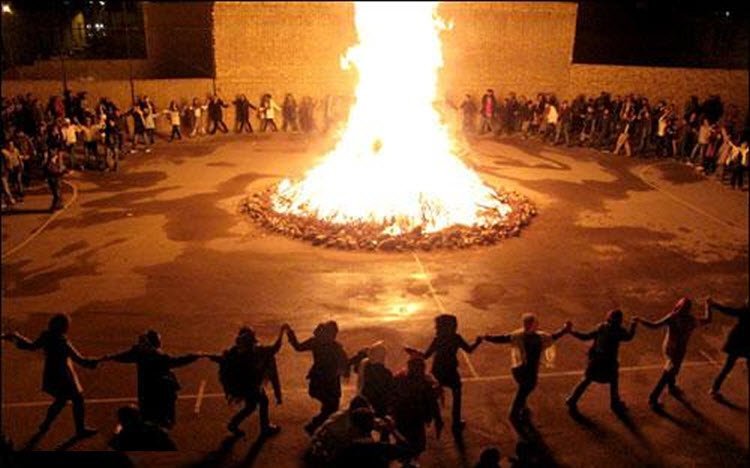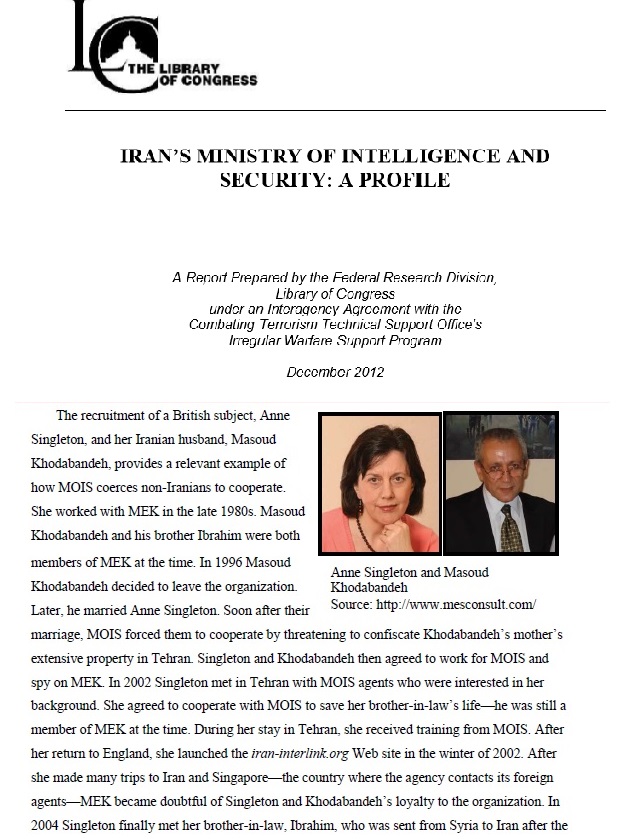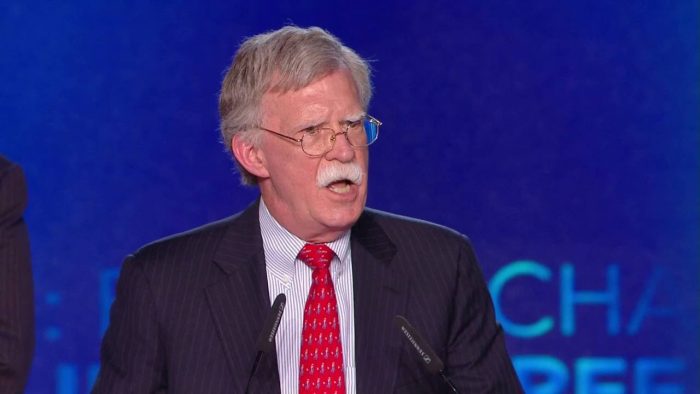POLITICAL PLATFORM
Demonstrations were staged in cities across Iran to take place during the yearly Fire Fest celebration, which marks the last week of Iran’s calendar year.
ISJ Report Warns of Potential Attack on MEK in Albania On Wednesday the International Committee In Search of [...]
John Bolton represents a new chapter in US-Iran relations Donald Trump’s appointment of John Bolton as the president’s [...]
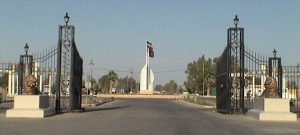
Entrance view of the City of Ashraf, Iraq-Diyala, previous residence of MEK in Iraq until 2013
Introduction
This overview tells the story of Camp Ashraf from its outset in 1986 until September 2013, when the last residents were forced to relocate to Camp Liberty.
Since the Iraqi government took control of the camps, 116 MEK (PMOI) members have been murdered and more than 1,300 injured.
The MEK (PMOI) members are “protected persons” under the Fourth Geneva Convention. They have been officially recognized as asylum seekers and people of concern by the UN Human Rights Committee (UNHRC), which also publicly declared they are protected persons be international law.
The MEK (PMOI) members are undergoing Refugee Status Determination (RSD). Many have already been recognized while others have yet to finish the process.
In 2004, the US government signed individual agreements with each MEK (PMOI) resident to protect them until their final disposition. The US government has a legal and moral obligation to ensure the MEK (PMOI) residents remain safe. But tragically it has failed to do so.
Despite multiple attacks on the MEK (PMOI) residents by Iraqi forces, there has yet to be a single impartial investigation of the killings and they remain highly vulnerable to additional attacks.
Camp Ashraf

The MEK (PMOI) had been granted a small piece of barren land in the desert, located near the Iranian border in Diyala Province. The site had no running water or electricity, just a handful of deserted and partially-constructed buildings.
Named Camp Ashraf, the facility rapidly expanded as MEK (PMOI) supporters in Europe and the US – many of them students and professionals – journeyed to the remote site. They all shared the dream of replacing the mullahs’ violent and authoritarian regime with a democratic progressive secular government.
In 1986, Iraq and Iran were in the fifth year of a war. In 1982, after 20 months of fighting had begun, Iraq withdrew its military forces from Iran and sued for peace. The mullahs could have ended the conflict under favorable terms. But Ayatollah Khomeini refused to do so and pledged to continue fighting until Saddam was toppled and replaced with an Islamic republic.
The MEK (PMOI) opposed the continuation of hostilities and mounted an international campaign to end the war. The MEK (PMOI)’s close proximity to the Iranian border gave hope to the Iranian people, who also desperately wanted an end to the hostilities. The MEK (PMOI) hoped to spark a general uprising by striking inside Iran, which would lead to the downfall of the fundamentalist mullahs.
The MEK (PMOI)’s small band of soldiers rapidly swelled into a large military force dubbed the National Liberation Army (NLA). Its operations were completely independent of the Iraqi forces and were not involved in any of the Iran-Iraq confrontations.
While Iraq’s soldiers remained in a defensive posture, the NLA initiated cross-border raids against Iran’s Revolutionary Guards. In March 1988, the NLA launched its first major offensive, deploying tanks and armored vehicles ten miles into Iran. In its next large strike, the NLA battled two Iranian divisions along a 31-mile front. The Revolutionary Guards suffered large casualties and more than 2,000 soldiers were taken, prisoner.
Soon thereafter, Khomeini accepted a UN ceasefire, ending the war. The NLA, with each new offensive, was penetrating deeper into Iran, fueling panic by the mullahs. The next assault might well spark a revolution that would reach all the way to Tehran. Rather than risk the regime’s demise, Khomeini agreed to end the conflict.
Ashraf City
![Thousands of people traveled to Camp Ashraf with one goal in mind - replace the mullahs' religious dictatorship with democracy. The PMOI continues to this day to inspire Iranians and give hope for ending the corrupt and violent Iranian regime. In a February 2013 telethon, many Iranians, risking their lives, made donations and voiced their solidarity for the PMOI. Common were states as: "Freedom is the right of everyone in the world and I support you." "I and three my sisters [sic] support you, the shining light in our house." "You inspire me and it is my responsibility to pass to other what I hear from you."](https://mek-iran.com/wp-content/uploads/2014/03/Ashraf-City-200.jpg)
The MEK (PMOI) remained committed to its sole objective – bringing change in Iran and establishing a democratic system. Ashraf City’s close proximity to Iran was an important element to realizing this objective.
Ashraf was often targeted in aerial bombardments and missile attacks by the Revolutionary Guards. But casualties were minimal due to secure bunkers and its vast size, which made it difficult to inflict heavy casualties.
Next Battles
The MEK (PMOI)’s next large-scale confrontation occurred on the heels of Saddam’s defeat in the first Gulf War. In the chaotic aftermath, Iran’s Revolutionary Guards crossed into Iraq in a major offensive to annihilate the MEK (PMOI) once and for all. Iran’s forces suffered huge losses and retreated in defeat in counterattacks mounted by the MEK (PMOI).
In early 2003, Multinational forces led by the United States prepared to invade Iraq. The MEK (PMOI) consolidated its forces at Camp Ashraf and nearby smaller facilities to avoid any involvement in the conflict – the same strategy it had successfully implemented in the first Gulf War.
Unbeknownst to the MEK (PMOI), in secret negotiations with Iran, the US offered to bomb Camp Ashraf if the mullahs, in return, agreed to stay out of the war. An agreement was struck. Despite the MEK (PMOI)’s declaration of neutrality, the US and British air forces repeatedly bombed Camp Ashraf and other camps, killing nearly 50 people.
The MEK (PMOI) offered no resistance with the Multinational Forces arrived at the gates of Camp Ashraf. The MEK (PMOI) residents refused to surrender because they had not engaged in any fighting. They subsequently signed an agreement of “mutual understanding and coordination” and later voluntarily handed over their weapons. In return, they were promised protection.
Protected Persons
The Multinational Forces led by the US conducted an exhaustive 16-month investigation of the MEK (PMOI) members and its activities in Iraq. No basis was found to bring any charges against the MEK (PMOI) members and on July 21, 2004, US Army Major Geoffrey D. Miller delivered a letter to each resident at Camp Ashraf congratulating them on “their recognition as protected persons under the Fourth Geneva Convention.”
The designation means the MEK (PMOI) was not found to be enemy combatants and had not fought with the Iraqi army against the Multinational Forces.
Among their rights as protected persons as defined in the Fourth Geneva Convention, the MEK (PMOI) residents have the right to protection from danger, violence, coercion, and intimidation; the right to food and health care; the right to contact their families outside Camp Ashraf; the right to fair treatment under the law; and the right to pursue employment opportunities and profit-making activities.
Transfer of Responsibility
The United States signed an agreement with Iraq, pledging to withdraw its combat forces from Iraqi cities by June 30, 2009. As part of the agreement, the protection of the unarmed MEK (PMOI) members at Camp Ashraf was transferred to the Iraqi government in early 2009.
The MEK (PMOI) opposed the transfer, stating it would endanger their security. This view was supported by man jurists and international organizations.
The US said it had received written assurances from the Iraqi government that it would provide humane treatment of the Ashraf residents in accordance with Iraq’s Constitution, laws, and international obligations.1
The assurances by the Iraqi government were without merit. Iraqi Prime Minister Nouri al-Maliki is beholden to the Iranian regime, which has exerted its considerable political influence in Iraq to keep his in power. In return, al-Maliki does the mullahs’ bidding, which includes targeting the MEK (PMOI) residents.
Human Rights Violations

- Impede and/or block deliveries of food, fuel, water, and medical supplies.
- Ban the delivery of spare parts to maintain the Camp’s water purification plant and power station.
- Ban the delivery of everyday items, such as light bulbs and paper.
- Surround the Camp with 300 loudspeakers that blared threats and insults day and night.
Tahar Boumedra, former Chief of the Human Rights Office of the United Nations Assistance Mission for Iraq (UNAMI), was responsible for monitoring human rights at Camp Ashraf from 2009-2012. He weekly traveled to the facility to assess events. Boumedra stated:
“The fundamental rights of these exiles [Ashraf residents] – humane living conditions, access to justice, humanitarian necessities including medical services for the ill and wounded, and freedom from threats of physical harm – have been repeatedly denied by the Iraqi government at the direction of the Prime Minister’s office.”2
Murderous Attacks
To “guard” Camp Ashraf, the Iraqi army manned observation towers positioned outside the perimeter fence. Iraqi soldiers and police officers were stationed at all gates and had barracks along three sides of the camp. Gaining access to Ashraf was not possible without the awareness of the Iraqi forces.
The unarmed Ashraf residents suffered three major attacks that killed 116 people and injured another thousand. The attacks were perpetrated by Iraqi military and police forces.
- July 28-29, 2009 – Iraqi armed forces attacked Ashraf residents, killing 13 people and wounding many others, according to Tahar Boumedra.
Also participating in the attack, he said, “were [military] units from Baghdad, police units from Diyala province, and Iraqi Special Forces from the notorious 56th Brigade under the command of the Prime Minister [Nouri al-Maliki].”3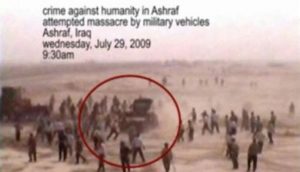
A crime against humanity, Iraqi forces attack Camp Ashraf residents-July 2009
- April 8, 2011 – Thirty-six residents were murdered and 318 wounded. As described by Boumedra, “In a move into Ashraf, the Iraqi army used sound and smoke grenades and tear gas. When the residents gathered to create a human barricade in the face of the advancing forces, the army opened fire on them. Snipers were used to hunting camerawomen who were filming the attack and HUMVEEs were driven at high speed into crowds of residents.”4
- September 1, 2013 – Armed men with protective armor and white camps entered Camp Ashraf and shot unarmed residents, murdering 52 people. “All the deceased appeared to have suffered gunshot wounds, the majority of them in the head and the upper body, and several with their hands tied,” according to the UN.5
Kobler’s “Dishonest Behavior”
Martin Kobler, a high-ranking German politician, was appointed Special Representative for Iraq and the Head of UNAMI in August 2011. Upon his arrival in Baghdad, he announced his top priority was the closure of Camp Ashraf.

Kobler then negotiated and signed without the agreement of the MEK (PMOI) residents a Memorandum of Understanding (MOU) with the Iraqi government that required the residents to relocate to a “temporary transit location.”
The MOU fell short of upholding the residents’ basic rights as protected persons and asylum seekers under the 1951 refugee convention. Despite this failing, the UNAMI and US government declared the MEK (PMOI) residents would be safe at Camp Liberty and would soon be relocated to third countries outside of Iraq.
Forcing the MEK (PMOI) to move to another camp in Iraq would do nothing to expedite their relocation to other countries. But it did weaken their security at Ashraf and Liberty, as well as degrade their living standards.
As a result of Kobler’s “authoritarian and dishonest behavior,” most of the senior staff at UNAMI left the organization, according to Boumedra.6
Camp Liberty
Camp Liberty, an abandoned military base near the Baghdad airport, was selected as the temporary transit location site. Kobler refused to allow MEK (PMOI) residents to assess the infrastructure at Liberty before moving there.
The camp clearly did not meet internationally recognized standards. It was not connected to the city electrical grid, its generators were old and worn out, and there was no running or potable water. It did not have a sewage system, there was no public lighting, and the dining facility and kitchen had been looted and vandalized. The residents had to live in thin-paper wall trailers, and there were no recreational facilities or green areas.
A UNHCR shelter expert subsequently visited Camp Liberty and concluded it was unfit to accommodate the Ashraf residents. Kobler concluded otherwise in his own report, dated January 19, 2012.
Ten days later, on January 31, 2012, UNAMI distributed a press release that erroneously “confirmed that the infrastructure and facilities at Camp Liberty are in accordance with international humanitarian standards stipulated in the MOU.”7
Kobler included false information in his report to the Secretary-General to the Security Council. Kobler lied, stating “On 31 January, the Office of the United Nations High Commissioner for Refugees (UNHCR) determined that the infrastructure and facilities at Camp Hurriya [Camp Liberty] were in accordance with basic international humanitarian standards, as required by the memorandum of understanding.”8 Accompanying the report was highly selective pictures giving a false impression of the camp.
As a result of Kobler’s deceitful actions, Boumedra resigned in protest from his post at the UN. Boumedra said Kobler “misled the Ashrafis, the international community, and most dangerously he lied to the Security Council.”9
According to Boumedra, the MOU “signed on behalf of the United Nations violates each and every article of the Universal Declaration of Human Rights and the corresponding provisions of the ICCPR (International Covenant on Civil and Political Rights, a multilateral treaty adopted by the UN General Assembly in December 1966].10
In the months that followed, all but 100 MEK (PMOI) residents from Camp Ashraf were relocated to Camp Liberty, where they remain today. The residents at Liberty are being deprived of their basic human rights, including freedom of movement, visits from families, reporters, lawyers, NGOs, diplomats, and parliamentarians. Boumedra said Liberty, which measures only 0.6 square kilometers, reminded him of the “concentration camp” he lived in as a child during Algeria’s war of liberation.11
Attacks Continue
At Camp Liberty, the residents are constantly harassed by Iraqi intelligence officers stationed at the facility. Food shipments and medical supplies a regularly blocked from entering the site, and sewage trucks are prevented from leaving.

The UNAMI refused to do anything, while Kobler deceitfully claimed the residents wanted the T-walls to be removed. (The MEK (PMOI) only wanted the T-walls surrounding the area removed.)
As a result, the MEK (PMOI) residents today have minimal security. The Iraqi government has denied their requests for protective helmets and vests, concrete bunkers, T-walls, and materials to construct dual-layer roofs for their trailers – all of which the MEK (PMOI) offered to pay for.
The failure of Kobler and the UN to ensure the security of the MEK (PMOI) residents has led to the death of 15 MEK (PMOI) members and many wounded.
There have been three large strikes on Camp Liberty, perpetrated by militia and thugs controlled by al-Maliki, at the behest of the Iranian regime.
- February 9, 2013 – Eight MEK (PMOI) members were murdered and nearly 100 injured from a rocket and mortar attack.
- June 15, 2013 – Dozens of rockets hit the camp, setting fire to multiple trailers and killing two MEK (PMOI) residents.
- December 26, 2013 – Twenty Katyusha rockets and mortar rounds were fired at Camp Liberty, killing four residents and injuring 71 others.
US Government Remains Responsible
The Multi-National Force-Iraq led by the US government granted the MEK (PMOI) residents protected person status in 2004 under the Fourth Geneva Convention. It later, against strong opposition by the residents and advice of international organizations, transferred protection of the MEK (PMOI) to the Iraqi government, claiming it would comply with its obligations to protect the residents.
Instead, the Iraqi government has repeatedly violated the fundamental rights of the MEK (PMOI) members and perpetrated the murder and injury of many residents.

Repeated Failure to Investigate
While numerous government leaders, UN officials, and human rights organizations have called for independent investigations into the attacks on Camp Ashraf and Camp Liberty, nothing has happened.
The ongoing failure to bring the perpetrators to justice – in this case, the Iraqi government leaders –emboldens them to mount further attacks and shed more innocent blood.
Relocation of Camp Liberty residents to Albania and other parts of Europe
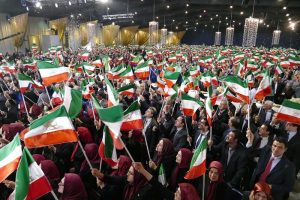
MEK gathering in Tirana-September 2018
In 2012 the MEK (PMOI) residents finally began the process of relocation to several European countries, including Albania, Germany, Norway, the United Kingdom, The Netherlands, Finland, Denmark, Belgium, Italy and Spain. The resettlement process took place over a period of four-and-a-half years and was completed on September 9, 2016, when the last group of residents from Camp Liberty, containing over 280 people, left the camp for Albania.
This final departure was the conclusion of years of struggle to move MEK (PMOI) members to locations outside of Iraq. The Iranian regime attempted to subvert this process until the very end with its conspiracies, obstructions, and threats.
As part of their attempts to prevent the relocation of MEK (PMOI) members, the religious dictatorship in Iran gave red notices to Interpol and used fake arrest warrants issued by its proxies, the Iraqi Judiciary to prevent 1,000 MEK (PMOI) members from leaving Iraq. They also used these tactics to arrest well-known members and MEK (PMOI) leaders.
The theocracy went further to take down the MEK (PMOI) by using the post-invasion atmosphere in Iraq to get away with launching a series of attacks on Camps Liberty and Ashraf. Camp Ashraf endured three assaults by the Iranian regime and Camp Liberty survived five missile strikes. Residents were obducted on two occasions, and the regime imposed a vicious eight-year siege, causing the deaths of 177 residents.
The Iranian regime was not content to see the MEK (PMOI) residents relocated outside of Iraq. Rather, the regime hoped to force the residents to surrender or failing that, to destroy them completely. They failed on both fronts, breathing new life into the resistance movement in Iran. This defeat took place as the regime dealt with demands for justice for the 30,000 political prisoners who were killed in 1988.
The National Council of Resistance of Iran NCRI) made its annual declaration just a few days before the last MEK (PMOI) members were relocated. In this declaration, the NCRI praised Mrs. Maryam Rajavi, its President-elect, for her tireless work on behalf of the Camp Liberty residents and their safe transfer to countries outside of Iraq. According to the NCRI, the relocation of MEK (PMOI) members was due in part to political pressure from respected American, European, and Arab supporters. This support made the regime and its Iraqi proxies willing to allow the departure of MEK (PMOI) members because they feared the political backlash if they did not.
The Iranian Resistance rallied around the MEK (PMOI) residents, and starting in 2015 the United States Congress introduced bills and passed legislation to protect and relocate Camp Liberty’s residents. The European Parliament, the British Parliament, and the governments of other European and Middle Eastern countries adopted similar measures.
On July 19, 2016, the United Nations High Commissioner for Refugees stated, “UNHCR is supporting a steady and growing stream of movements out of Iraq in coming months. It is hoped that the process will be completed well before year-end. This progress has been achieved with the cooperation of the residents who have proceeded with the relocation process despite difficult circumstances, including the attack on 4 July 2016, which fortunately did not result in any casualties.”
The UNHCR added, “Ongoing success in the implementation of solutions has also been assisted by the residents’ commitment to meeting the bulk of the associated costs, particularly for long-term support of all residents relocated out of Iraq who have no access to state-sponsored assistance.”
As Camp Liberty’s residents attempted to relocate, the Iranian regime’s ambassador to Iraq, a commander of the terrorist Quds Force, directed Iraqi intelligence agents to prevent the residents from taking their personal possessions with them. Residents were blocked from taking their computers, radios, and cell phones. Even electric shavers were prohibited.
In addition, once the residents had resettled, their property was supposed to be sold, under a previous agreement with an Iraqi merchant whom the government had approved. The property was originally meant to be sold for $10.7 million. Instead, the Iraqis prevented over 90% of their property from being sold, allowing the remaining 10% of their property to be sold at a quarter of market value.
The Iranian regime’s Quds Force made a final attempt to destroy the Camp Liberty in the final weeks before their resettlement. The Quds Force supplies missiles to three of its proxy groups (Kata’eb Hezbollah, Asa’eb Ahl Al-Haq, and Harakat al-Nujaba) and directed them to launch attacks on the camp as soon as possible Kata’eb Hezbollah stationed a truck loaded with missiles near Camp Liberty on August 19, 2016, but the Iraqi Federal Police uncovered their plants and prevented the attack.
1) “US Embassy Statement on Transfer of Security Responsibility for Camp Ashraf,” US Embassy – Iraq, December 28, 2008.
2) “Former UN Human Rights Chief in Baghdad Tahar Boumedra: Why I Quit UN in Iraq,” by Tahar Boumedra, The Hill, August 22, 2012.
3) “The Untold Story of Camp Ashraf,” by Tahar Boumedra, New Generation Publishing, 2013.
4) Ibid.
5) “UNAMI Delegation Visits Camp Ashraf to Assess the Situation Following Reports of Massacre,” UNAMI, September 3, 2013.
6) “The Untold Story of Camp Ashraf,” by Tahar Boumedra, New Generation Publishing, 2013.
7) “Preparation of Voluntary Relocation of Camp New Iraq Residents is Progressing,” Press Release, United Nations Assistance Mission for Iraq (UNAMI), January 31, 2012.
8) “The Untold Story of Camp Ashraf,” by tahar Boumedra, New Generation Publishing, 2013.
9) Ibid.
10) Ibid.
11) “Former UN Human Rights Chief in Baaghdad Tahar Boumedra: Why I Quit the UN in Iraq,” The Hill, August 22, 2012.

